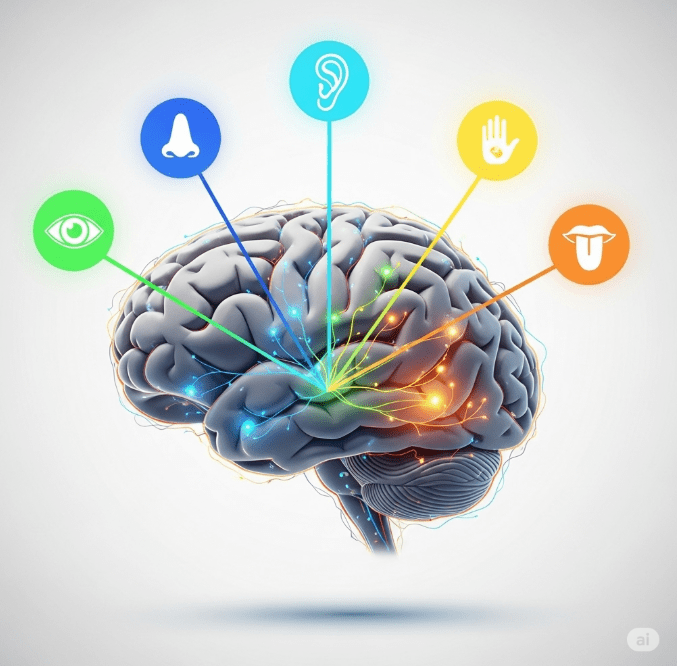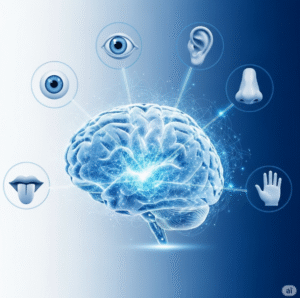How to Train Your Brain to Improve Your 5 Senses
Simple, science-backed steps to sharpen sight, hearing, smell, taste, and touch.
Strong senses help you work, play, and stay safe.
The best part is this: you can train them.
Neuroplasticity makes it possible. Your brain can change with practice.
This guide shows easy habits for each sense.
You will find drills, routines, and small daily tweaks.
They are short, safe, and fit a busy life.
Important note: health comes first.
If you feel pain or have sudden loss, see a doctor.
Use training as support, not as a cure.
Why Train Your Senses?
- Sharp senses boost focus and memory.
- They improve reaction time and safety.
- They make food, music, and art feel richer.
- They help mood and reduce stress.
The brain is like a muscle.
Use it, and it grows.
Leave it idle, and it weakens.
This is the core idea behind all drills here.
Daily Foundations for All Senses
Sleep well
Sleep resets brain circuits.
It supports vision, hearing, and smell processing.
Aim for seven to nine hours most nights.
Learn more about sleep and brain health
here.
Move your body
Exercise feeds the brain with oxygen and growth factors.
Even brisk walking helps.
Try 150 minutes each week as a goal.
See exercise guidance from
CDC.
Eat for your brain
Whole foods help nerve health.
Include greens, legumes, fruits, nuts, and seeds.
Add omega-3 sources like flax or walnuts.
Read a simple overview on brain-healthy eating
here.
Protect your senses
- Use sunglasses in strong sun.
- Wear hearing protection at loud events.
- Avoid harsh solvents and smoke.
- Handle hot or sharp items with care.
Practice mindful attention
Attention amplifies sensory input.
A minute of focus can sharpen a signal.
Try short breath breaks during the day.
Basic mindfulness tips are summarized
here.
Train Your Sight (Vision)
1) Near–far focus drill
Hold a card at arm’s length.
Focus on a letter for five seconds.
Switch to a far object for five seconds.
Repeat for two minutes.
This works your focus system.
2) Peripheral awareness walk
Pick a safe path.
Walk at an easy pace.
Keep eyes forward.
Notice movement at the edges of sight.
Name shapes silently.
Do five minutes.
3) Contrast hunt
Sit by a window.
Scan for light–dark edges.
Trace them with your eyes.
This sharpens edge detection.
Spend two minutes daily.
4) Blinking and breaks
Screens dry the eyes.
Use the 20-20-20 rule.
Every 20 minutes, look 20 feet away for 20 seconds.
Blink slowly ten times.
Eye strain tips from
AAO.
5) Color naming game
Spread colored items on a table.
Name each color quickly.
Then sort by hue and brightness.
This builds speed and precision.
Bonus care
Get regular eye checks.
Vision issues may need lenses or care.
Early help protects long-term sight.
See general guidance
here.
Train Your Hearing (Audition)
1) Frequency sweep
Play a tone sweep app at low volume.
Track the tone with attention.
Note where it feels faint.
Do two minutes.
2) Sound layering
Sit outside.
Close your eyes.
List three near sounds.
Then list three far sounds.
Shift back and forth for five minutes.
3) Speech in noise
Play soft background noise.
Listen to a podcast at a safe level.
Repeat key phrases aloud.
This trains focus in clutter.
4) Direction finding
Ask a friend to click a pen.
Keep eyes closed.
Point to the source.
Rotate positions.
Do three minutes.
Protect your ears
Keep volume under 60% with headphones.
Take breaks.
Use earplugs at concerts.
Read safe listening advice
from WHO.
Bonus care
If you hear ringing or muffled sound, get a hearing test.
Early checks help a lot.
Learn about tests
here.
Train Your Smell (Olfaction)
Smell training can improve scent and memory.
It helps after colds or long gaps.
It is simple and low cost.
1) Classic four-scent drill
Choose four scents, like rose, lemon, clove, and eucalyptus.
Sniff each for 15 seconds.
Rest 30 seconds between scents.
Repeat twice daily for three months.
This routine has supportive evidence.
Read summaries
here
and practical guidance
here.
2) Scent journaling
Keep small jars of spices or oils.
Label the bottom only.
Smell, guess, and then check the label.
Write three words for each scent.
This builds vocabulary and memory links.
3) Context switching
Smell coffee beans, then an herb, then citrus.
Switch context fast.
This sharpens discrimination.
Do for two minutes.
4) Breath pacing
Use slow nasal breaths for scent detection.
Inhale gently.
Hold one second.
Exhale slowly.
Repeat six times.
Protect your nose
Avoid smoke and harsh fumes.
Ventilate kitchens well.
Hydrate to keep nasal tissue moist.
See general smell health info
here.
Train Your Taste (Gustation)
Taste blends with smell and texture.
Training helps you eat mindfully and enjoy more.
It can support healthy choices.
1) Five-taste map
Prepare small samples: sweet, sour, salty, bitter, umami.
Taste each with eyes closed.
Describe intensity from one to ten.
Note how it changes with time.
2) Texture ladder
Compare crunchy, creamy, and chewy foods.
Focus on mouthfeel for 20 seconds each.
This sharpens attention and enjoyment.
3) Slow bite ritual
Take one bite.
Chew slowly for 20 to 30 seconds.
Notice flavor phases.
Swallow.
Pause before the next bite.
4) Flavor pairing game
Combine two simple foods, like tomato and basil.
Then try new pairs.
Describe what changes.
Build a flavor library in your mind.
Protect your taste
Do not smoke.
Reduce very hot drinks that may irritate tissue.
Maintain oral health.
See taste disorder basics
here.
Train Your Touch (Somatosensation)
Touch includes pressure, vibration, temperature, and pain.
It supports dexterity and balance.
Training helps fine control and safety.
1) Two-point discovery
Use a paperclip with two tips.
Touch your forearm with one or two points.
Eyes closed, guess one or two.
Test across the arm and hand.
This builds tactile acuity.
2) Texture box
Fill a bag with varied objects.
Reach in without looking.
Identify items by touch.
Describe edges, weight, and temperature.
3) Finger ladder
Place small beads on a table.
Pick them up one by one.
Sort by size with eyes closed.
Do for three minutes.
4) Balance micro-drills
Stand on one leg near support.
Hold for 20 seconds.
Switch legs.
Close eyes only if safe.
This trains proprioception.
Review balance safety basics
here.
Protect your skin and nerves
Moisturize dry skin.
Manage blood sugar if needed.
Use gloves for cold and rough work.
Learn about nerve health
here.
Mind–Sense Integration Drills
Many skills use more than one sense.
These drills build cross-talk in the brain.
They also keep training fun and fresh.
1) See–hear sync
Watch a metronome app.
Clap with each click.
Then clap just before the click.
Then just after.
This trains timing and prediction.
2) Smell–taste story
Smell a food first.
Describe three notes.
Then taste it.
Note which smell notes grow or fade.
Write a short flavor story.
3) Touch–vision mismatch
Place an object in a bag.
Feel and sketch it without looking.
Compare sketch with the real item.
This strengthens mental models.
4) Sound–space mapping
Sit in a room.
Close eyes.
Map sound sources in your mind.
Open eyes and check accuracy.
Adjust and repeat.
Build a 30-Day Sense Training Plan
Keep it light and steady.
Two short blocks each day are enough.
Choose one block in the morning and one at night.
Weeks 1–2: Learn and explore
- Day 1–3: Vision drills and a short walk scan.
- Day 4–6: Hearing drills with tone sweep and layering.
- Day 7: Rest and review.
- Day 8–10: Smell training and journaling.
- Day 11–13: Taste mapping and slow bite ritual.
- Day 14: Rest and review.
Weeks 3–4: Mix and deepen
- Alternate two senses per day.
- Add one integration drill every other day.
- Keep foundations: sleep, movement, and mindful breaks.
Track your progress in a simple log.
Note time, drill, and an intensity score.
Write one insight daily.
Small notes help you stay on track.
Make It Stick: Habit Tips
Use triggers
Attach a drill to a routine.
Do near–far focus after you make tea.
Do a smell drill before lunch.
Keep it visible
Place tools in sight.
Keep scent jars on your desk.
Keep earplugs by your keys.
Start tiny
One minute is fine.
The goal is consistency.
Once it feels easy, add time.
Reward the streak
Mark a calendar box after each session.
Give yourself a small treat weekly.
Protect the chain.
When to See a Professional
- Sudden vision changes or eye pain.
- New hearing loss, ringing, or ear pain.
- Loss of smell or taste after illness.
- Numbness, burning, or sharp nerve pain.
- Frequent falls or severe balance issues.
Early care prevents larger problems.
Find medical guidance through your local provider.
You can also explore trusted overviews at
MedlinePlus.
Tools and Apps You Can Use
- Metronome apps: train timing for hear–see sync.
- Tone generator apps: run gentle frequency sweeps.
- Mindfulness apps: guide short attention breaks.
- Color picker apps: improve hue naming and contrast spotting.
- Journaling apps: log drills and insights daily.
Keep volumes safe and sessions short.
Stop if you feel strain or dizziness.
Resume later with lower intensity.
Evidence and Further Reading
- Neuroplasticity overview:
APA. - Sleep and brain clearing:
NIH. - Physical activity basics:
CDC. - Eye strain and computer use:
American Academy of Ophthalmology. - Safe listening and hearing health:
WHO. - Hearing tests and care:
NIDCD. - Smell training background:
BMJ
and
Fifth Sense. - Taste disorder basics:
NIDCD. - Balance exercise safety:
NIA. - Peripheral nerve health overview:
Mayo Clinic. - Mindfulness research summary:
NCCIH. - General health library:
MedlinePlus.
Sample 10-Minute Daily Routine
- One minute of slow nasal breathing.
- Two minutes of near–far focus for vision.
- Two minutes of sound layering outside or near a window.
- Two minutes of scent identification with two jars.
- Two minutes of slow bite tasting with one food.
- One minute of balance practice near a support.
Keep it short.
If you want more, add only two minutes.
Small steps build strong habits.
Frequently Asked Questions
How soon will I notice changes?
Many people feel subtle gains in two weeks.
Clear gains often show in four to eight weeks.
Consistency matters more than length.
Can I overtrain my senses?
Yes, if you push too hard.
Use low intensity and short blocks.
Stop if you feel strain or pain.
Do I need special gear?
No.
Simple items work well.
Use cards, spices, a metronome app, and a journal.
What if I have allergies or sinus issues?
Train gently.
Avoid triggers.
Speak with a clinician for care options.
Use smell training only when you feel well.
Will this help with aging?
It can support function.
It will not replace medical care.
Combine training with sleep, exercise, and checkups.
Wrap-Up
You can train your senses at any age.
Use short, daily drills.
Protect your eyes and ears.
Move your body and sleep well.
Pay mindful attention to the world.
Your brain will adapt and grow.
Start today with one tiny step.
Pick one drill and do one minute.
Tomorrow, do two.
Keep going, and enjoy the richer world you build.








